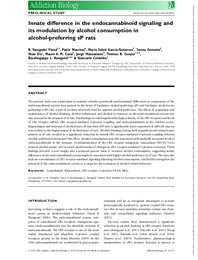Please use this identifier to cite or link to this item:
https://hdl.handle.net/11000/35432Full metadata record
| DC Field | Value | Language |
|---|---|---|
| dc.contributor.author | Vinod, K. Yaragudri | - |
| dc.contributor.author | Maccioni, Paola | - |
| dc.contributor.author | García Gutiérrez, María Salud | - |
| dc.contributor.author | Femenía Cantó, Teresa | - |
| dc.contributor.author | Xie, Shan | - |
| dc.contributor.author | Carai, Mauro A. M. | - |
| dc.contributor.author | Manzanares, Jorge | - |
| dc.contributor.author | Cooper, Thomas B. | - |
| dc.contributor.author | Hungund, Basalingappa L. | - |
| dc.contributor.author | Colombo, Giancarlo | - |
| dc.contributor.other | Departamentos de la UMH::Farmacología, Pediatría y Química Orgánica | es_ES |
| dc.contributor.other | Departamentos de la UMH::Farmacología, Pediatría y Química Orgánica | es_ES |
| dc.contributor.other | Departamentos de la UMH::Farmacología, Pediatría y Química Orgánica | es_ES |
| dc.date.accessioned | 2025-01-28T18:47:53Z | - |
| dc.date.available | 2025-01-28T18:47:53Z | - |
| dc.identifier.citation | Addiction Biology, 2012;17(1):62 -75 | es_ES |
| dc.identifier.issn | 1355-6215 | - |
| dc.identifier.issn | 1369-1600 | - |
| dc.identifier.uri | https://hdl.handle.net/11000/35432 | - |
| dc.description.abstract | The present study was undertaken to examine whether genetically predetermined differences in components of the endocannabinoid system were present in the brain of Sardinian alcohol-preferring (sP) and Sardinian alcohol-nonpreferring (sNP) rats, a pair of rat lines selectively bred for opposite alcohol preference. The effects of acquisition and maintenance of alcohol drinking, alcohol withdrawal, and alcohol re-exposure on the endocannabinoid system was also assessed in the striatum of sP rats.The findings revealed significantly higher density of the CB1 receptors and levels of CB1 receptor mRNA, CB1 receptor-mediated G-protein coupling, and endocannabinoids in the cerebral cortex, hippocampus and striatum of alcohol-naive sP rats than sNP rats. A significantly lower expression of mFAAH enzyme was evident in the hippocampus of alcohol-naive sP rats. Alcohol drinking (during both acquisition and maintenance phases) in sP rats resulted in a significant reduction in striatal CB1 receptor-mediated G-protein coupling whereas alcohol withdrawal attenuated this effect. Alcohol consumption was also associated with markedly increased levels of endocannabinoids in the striatum. Co-administration of the CB1 receptor antagonist, rimonabant (SR141716A) reduced alcohol intake, and reversed alcohol-induced changes in CB1 receptor-mediated G-protein activation. These findings provided a new insight into a potential genetic basis of excessive alcohol consumption, suggesting innate differences in the endocannabinoid system might be associated with higher alcohol preference in sP rats. The data also indicate a modulation of CB1 receptor-mediated signaling following alcohol consumption, and further strengthen the potential of the endocannabinoid system as a target for the treatment of alcohol related behaviors. | es_ES |
| dc.format | application/pdf | es_ES |
| dc.format.extent | 14 | es_ES |
| dc.language.iso | eng | es_ES |
| dc.publisher | John Wiley & Sons | es_ES |
| dc.rights | info:eu-repo/semantics/openAccess | es_ES |
| dc.rights | Attribution-NonCommercial-NoDerivatives 4.0 Internacional | * |
| dc.rights.uri | http://creativecommons.org/licenses/by-nc-nd/4.0/ | * |
| dc.subject | Anandamide | es_ES |
| dc.subject | Rimonabant | es_ES |
| dc.subject | CB1 receptor | es_ES |
| dc.subject | G-protein | es_ES |
| dc.subject | FAAH | es_ES |
| dc.subject | MGL | es_ES |
| dc.subject.other | CDU::6 - Ciencias aplicadas::61 - Medicina::615 - Farmacología. Terapéutica. Toxicología. Radiología | es_ES |
| dc.title | Innate difference in the endocannabinoid signaling and its modulation by alcohol consumption in alcohol-preferring sP rats | es_ES |
| dc.type | info:eu-repo/semantics/article | es_ES |
| dc.relation.publisherversion | 10.1111/j.1369-1600.2010.00299.x | es_ES |

View/Open:
Innate difference in the endocannabinoid signaling and its modulation by alcohol consumption in alcohol-preferring sP rats.pdf
601,24 kB
Adobe PDF
Share:
.png)
